Welding is a fundamental skill that plays a role in a number of industries, including construction, manufacturing, automotive, aerospace and energy production sectors. Understanding weld positions is essential for creating high-quality welds. This article brings you the basic knowledge you need to understand welding positions, as well as their applications, their numerical designations and the techniques required to perform welding in different positions.
Welding Positions
Welding positions are the different orientations in which it is possible to weld on a particular joint. The position of the joint and the direction in which the weld is made have a significant influence on the welding technique and the quality of the weld.
Basic Welding Positions
The basic welding positions form the basis of welding techniques and are often a determining factor in matters such as quality, productivity, skill and technique.
Welding positions are indicated by their numerical designation and the type of weld joint being performed. Note that "G" refers to a groove weld and "F" means a fillet weld.



FLAT POSITION (1F AND 1G)
In the flat position, the axis of the welded joint is horizontal and the weld is made at the top of the joint. A flat position weld is the easiest weld to perform. Gravity holds the molten weld metal in place, with little additional effort from the welder. It is generally advisable to weld in a flat position as much as possible for two main reasons..
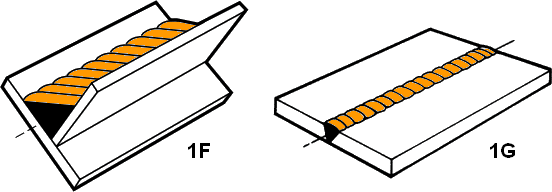
- Productivity - Because the molten weld pool remains in place much more easily in a flat position, the welder can use much higher temperatures and larger electrodes and/or filler metals, increasing the deposition rate. (The deposition rate refers to the amount of filler metal that can be deposited in the weld joint in a given unit of time.)
- Skill and ability – Because gravity helps to hold the molten weld pool in place and little to no additional effort is required from the welder, less skill is required to make welds in the flat position. Beginner level welders often learn about welding joints in the flat position before moving on to more challenging welding positions.
HORIZONTAL POSITION (2F AND 2G)
In the horizontal position, the weld is performed on the side of the joint and the weld axis is horizontal.
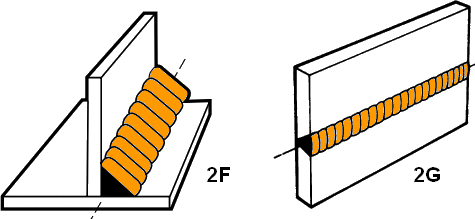
This dynamic requires the welder to adjust heat and travel speed to prevent excess molten weld metal from falling out of the weld joint.
VERTICAL POSITION (3F AND 3G)
In the vertical position, the welded joint is oriented straight up and down, with the axis of the joint in the vertical position. Welding in vertical position requires careful control of welding parameters to keep the molten weld metal in the weld joint and prevent it from falling out. Heat, travel speed and filler metal size are all important factors when welding in a vertical position.
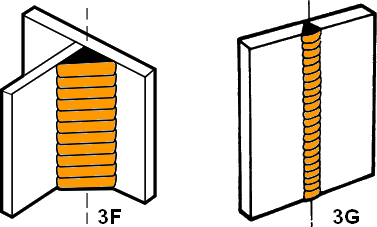
Welding uphill or downhill in vertical position
The welder can start welding at the bottom, upwards (as is the case when welding structural steel) or at the top, downwards (as is common when welding pipelines). The applicable welding codes, welding process and designated filler metals are some of the many factors that determine whether a welder will use vertical up or vertical down welding.
TOP POSITION (4F AND 4G)
Overhead position welding is performed at the bottom of the joint, with the welder looking up from below. Overhead welding can be the most challenging due to the simple fact that gravity negatively affects the weldability of the joint.

The welder must use enough heat to ensure good weld penetration, but not so much that there is too much weld metal in molten form, which would cause excess weld metal to fall out. Again, heat, travel speed, filler metal size and technique affect the success of overhead welds.
ADVANCED WELDING POSITIONS
In addition to the four basic welding positions described above (which mainly cover plate welding positions found in structural steel welding), there are more advanced positions that are often found in more specialized applications in the welding industry, such as in process piping.
The welder must use enough heat to ensure good weld penetration, but not so much that there is too much weld metal in molten form, which would cause excess weld metal to fall out. Again, heat, travel speed, filler metal size and technique affect the success of overhead welds.
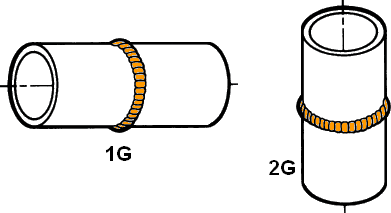
1G POSITION for PIPE
The 1G position is the simplest type of pipe weld, a horizontal rolled weld. In this type of welding, you weld from above the pipe and rotate along the X axis as you complete the weld. If the pipes are small, you can twist them yourself. For larger pipe spools, you will need to use equipment to rotate the pipe.
2G POSITION for PIPE
2G vertical welds are a little more difficult to perform than horizontal welds because you are welding from the side of the workpiece rather than directly above it. You may have to physically move around the pipe to complete the weld, which can distract you from your focus. If you are working on a vertical weld, make sure to clear the area around you first.
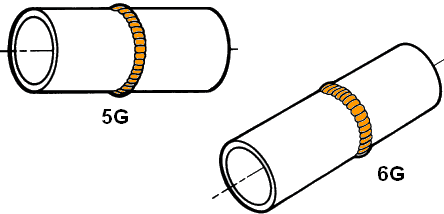
5G POSITION
In the 5G position, the tube is in the horizontal plane, similar to the 1G position. The difference is that the tube is fixed in this position and does not move or rotate during the welding process.
6G AND 6GR POSITIONS
With 6G position welding, the pipe is placed in a fixed position at a 45 degree angle. The 6G position is the most challenging weld to perform and requires a high level of skill and dexterity. The welder must be able to weld the pipe in all positions within the weld joint, without turning the pipes.
Welders use the “R” in the 6GR designation to indicate the use of a restriction. This means that they place a type of restrictive ring close to and on one side of the weld joint. This forces the welder to make the weld from only one side of the weld joint. (This is commonly found in weld testing for operations in refineries or other facilities where it may be necessary to perform welding with limited access.)
PIPE WELDING
Pipe welding can be more challenging because the welder may need to weld in all positions within the same joint. For this reason, pipe welding regulations contain their own specific designations. When pipe welding it is possible to use both groove welds and fillet welds. As with plate welding positions, these are indicated by "F" or "G" along with the appropriate number.
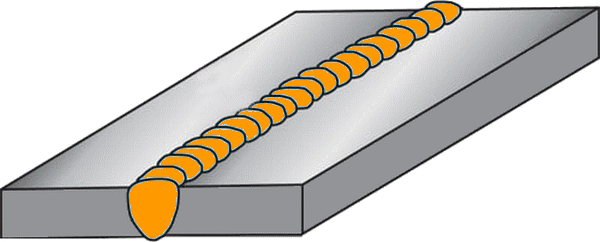
Remark(s)...
Welding disclaimer.. www.wermac.org (Werner) is based on information from multiple sources and my own experience with welding. It is not a substitute for the manufacturer's instructions and is intended only as a reminder for experienced welders.
Related Post(s)
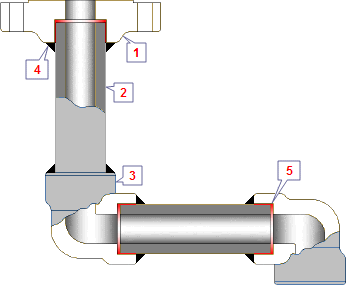
Good joint design is based on design specifications described in various welding codes or standards used in professional welding. The joint design determines what type of weld the operator must produce to meet the acceptable quality...